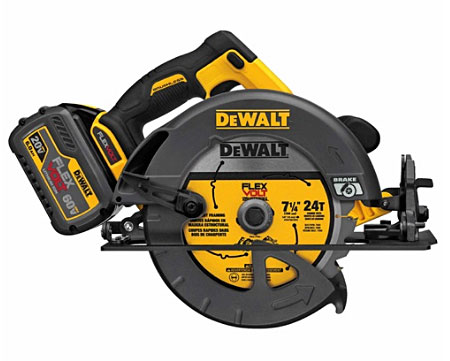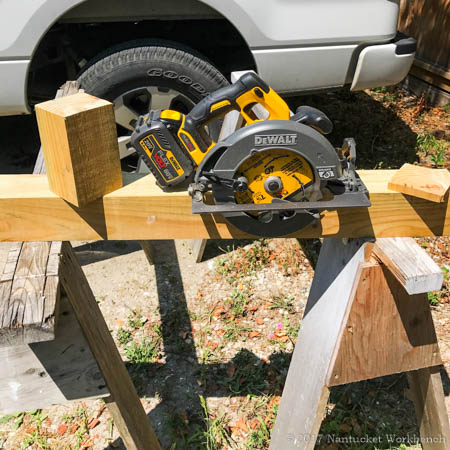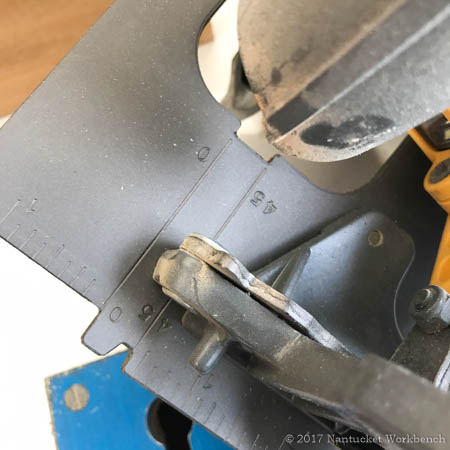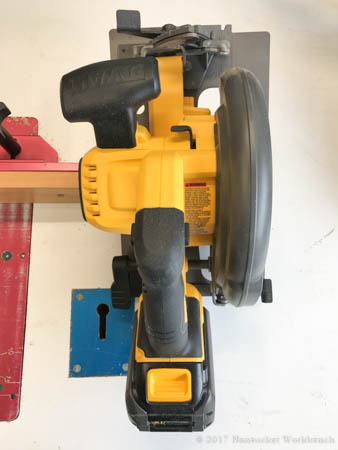 If you look around at my collection of power tools, you will no longer find a corded circular saw. At first it seemed like a risk to do without, but with the rapid maturation of cordless tools, it made little sense to keep one. There was nothing wrong with it other than that ropy thing coming out of the handle, but rather than store it, I sold it. Cheap, too.
If you look around at my collection of power tools, you will no longer find a corded circular saw. At first it seemed like a risk to do without, but with the rapid maturation of cordless tools, it made little sense to keep one. There was nothing wrong with it other than that ropy thing coming out of the handle, but rather than store it, I sold it. Cheap, too.
The DeWalt FlexVolt 60v MAX saw is one that is setting a lot of professionals free of cords. Cordless saws of even a year ago might have forced one to choose between convenience and adequate power, but there is no longer a need to compromise. The FlexVolt easily rips long pieces of 2x lumber at 90° or 45° and crosscuts so well that I have barely detected a rev drop when cutting pressure treated 4x4s.
 Those pressure treated 4x4s were the first things I cut when I had a 6.0Ah battery charged up. “Like buttah”, as we say in Massachusetts. I cut a pile of slices, listening carefully to each cut. The saw breezed through at full depth with what seemed like no effort. Of course it doesn’t cut a 4×4 in one pass, but with the piece flipped over, it was easy to track through the cut without drawing another line.
Those pressure treated 4x4s were the first things I cut when I had a 6.0Ah battery charged up. “Like buttah”, as we say in Massachusetts. I cut a pile of slices, listening carefully to each cut. The saw breezed through at full depth with what seemed like no effort. Of course it doesn’t cut a 4×4 in one pass, but with the piece flipped over, it was easy to track through the cut without drawing another line.
 The FlexVolt has more than enough power to rip 2x stock. I did run into issues here, as the accompanying picture shows: it was tough to rip a straight line. Most of the problem was due to excessive blade flex but some of the difficulty was that the saw wanted to track to the right. Changing the blade to one with a little more stiffness made a difference, but it still took some wrist action to keep it straight. The picture shows one cut attempted with no counter-steering added. You can see the cut on the far end (coming toward the camera) veer away from the chalk line.
The FlexVolt has more than enough power to rip 2x stock. I did run into issues here, as the accompanying picture shows: it was tough to rip a straight line. Most of the problem was due to excessive blade flex but some of the difficulty was that the saw wanted to track to the right. Changing the blade to one with a little more stiffness made a difference, but it still took some wrist action to keep it straight. The picture shows one cut attempted with no counter-steering added. You can see the cut on the far end (coming toward the camera) veer away from the chalk line.
Another test of the FlexVolt involved cutting a stack of Douglas Fir 2x stock that had been out in the rain for several days. I offered the saw to a coworker who easily crosscut the stack, and, once again, there was barely a discernible rev drop on any of the cuts. Needless to say, the old school guy was impressed.
 The depth adjustment and angle adjustments are conventional and easy to use. The handle is comfortable, although just a bit on the small side. My hands aren’t particularly big, so I wonder how the ham-fisted will find it. The safety buttons aren’t hard to reach, but I prefer the kind that move down as opposed to 90° as it feels more natural to me.
The depth adjustment and angle adjustments are conventional and easy to use. The handle is comfortable, although just a bit on the small side. My hands aren’t particularly big, so I wonder how the ham-fisted will find it. The safety buttons aren’t hard to reach, but I prefer the kind that move down as opposed to 90° as it feels more natural to me.
A welcome detail I would not have thought of is the addition of long guide lines on the shoe. They make it much easier to keep the blade aligned with the cut line than a simple scale or notch. (Both of which are included)
 Any discussion of circular saws these days involves the great blade-right vs. blade-left debate. Without going too deeply into the pros and cons of each, and whether or not they suggest right-handed or left-handed use, it must be pointed out the the top handle on this blade-right saw, if you are a frequent top handle user, pushes it heavily toward righty-only due to its considerable offset to the left. These new cordless saws have much narrower motor housings that provide less room for mounting than their corded predecessors, but this offset could make it awkward for lefties.
Any discussion of circular saws these days involves the great blade-right vs. blade-left debate. Without going too deeply into the pros and cons of each, and whether or not they suggest right-handed or left-handed use, it must be pointed out the the top handle on this blade-right saw, if you are a frequent top handle user, pushes it heavily toward righty-only due to its considerable offset to the left. These new cordless saws have much narrower motor housings that provide less room for mounting than their corded predecessors, but this offset could make it awkward for lefties.
 I assume that the tool industry has taken to heart a valuable lesson with this and a few other products: always include a “rafter hook”! There has been such an outcry over that lack with this one that newer models have one included. No retrofit, though. Not a big deal for me as I nearly always did my cutting at horses on the ground or up on the deck, it being exceedingly rare to cut up on walls or joists or rafters. I guess that’s not the norm any more. Besides, if you hook the saw on a rafter, won’t it slide down to the plate, out of reach?
I assume that the tool industry has taken to heart a valuable lesson with this and a few other products: always include a “rafter hook”! There has been such an outcry over that lack with this one that newer models have one included. No retrofit, though. Not a big deal for me as I nearly always did my cutting at horses on the ground or up on the deck, it being exceedingly rare to cut up on walls or joists or rafters. I guess that’s not the norm any more. Besides, if you hook the saw on a rafter, won’t it slide down to the plate, out of reach?
No matter! This is an outstanding saw, hook or no hook. It has great power from only one battery, it’s reasonably compact, and considerably lighter than some of the competition. It’s one that I keep nearby at all times.
-dvl
PS – I’ll be looking for an example of DeWalt’s coming Rear Handle FlexVolt Saw to compare!


Leave A Comment